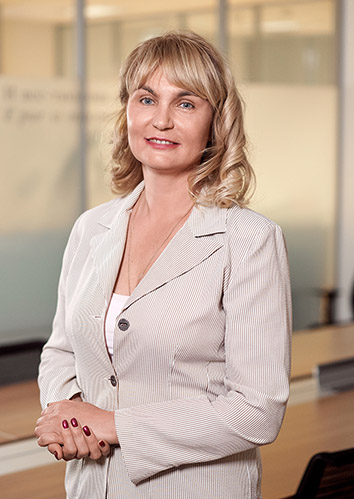The spotlight currently sits on data centres regarding their sustainability efforts and with the increasing pressure to take ESG goals seriously and a lack of usable metrics, it can be a difficult area to navigate. Natalya Makarochkina, Senior Vice President of the Secure Power Division at Schneider Electric tells us how organisations can best use sustainability strategies, the purpose of ESGs and the current sustainability landscape of data centres in the Middle East and internationally.

With enterprises in the Middle East being urged to develop sustainable technology strategies, how should CIOs address the whole sustainability agenda in their organisations?
For every CIO, sustainability must not only be high on the agenda, but a constant thread through everything they do. For most CIOs in larger companies, they have been making some kind of sustainability effort in recent years. This is being driven by a few factors.
Firstly, general awareness of the need to reduce emissions, as highlighted by high level reports such as those from the Intergovernmental Panel on Climate Change (IPCC) and gatherings such as COP26, based on widely collected data from multiple sources and disciplines that show the extent of human-influenced climate change.
Secondly, capital in markets is now becoming sustainable, driven by the needs highlighted in these reports. McKinsey describes data centres and technologies like hydrogen distribution as next-generation investments, highlighting that traditional risk-based classifications for infrastructure investing “are being challenged by fundamental drivers led by the energy transition, including sustainability targets, electric mobility and digitisation.”
Thirdly, customers are now including sustainability credentials as part of their purchasing deals. RFPs now have sustainability sections, looking for hard metrics.
In light of all this, the CIO has a key role in providing the information and management systems that will allow an organisation to understand its full impact, from Scope 1-3 emissions. Only with that full understanding will an organisation be able to confidently meet emissions regulations, fulfil ESG commitments and have those achievements differentiate it as a responsible global citizen when doing business.
What is environmental, social and governance (ESG) and why should it matter to CIOs or any IT leader?
ESG is the strategy and action plan of a business to be environmentally and socially responsible, through a well governed policy programme, with sustainability at its heart.
Sustainability has to be an integral part of business going forward, but it is also a risk management essential and a company’s path to the future; it is a way to foster innovation and differentiate your business in a competitive market.
There are challenges to overcome with climate change, social unrest, reputational impacts from unethical conduct and changing consumer preferences. However, there are also opportunities, in innovation, resilience, recognition, cost-savings, talent acquisition and retention and Disaster Recovery preparedness.
The CIO has a key role in all of this to ensure that the IT systems and infrastructure are there to support efficiency, as well as manage the systems that will gather the right data, analyse it and turn into actionable intelligence to guide the COO, CFO and CEO in doing what is necessary.
Schneider Electric has written extensively on this, sharing our findings in a range of reports and tools on sustainability, ESG reporting, shared frameworks and developing a sustainability disclosure dashboard.
What specific criteria should CIOs consider for ESG? And regionally, for organisations in the Middle East?
ESG reporting in general needs to consider some key points.
When building and growing your company’s ESG reporting practice, you need to determine firstly which topics to address. Your level of ESG sophistication, industry, geography and other factors influence what your company should report on. Understanding this and identifying priorities is known as a “materiality assessment.”
Then, identify which level of material assessment is necessary. Materiality assessments can vary in depth and inclusivity. A more extensive and comprehensive study will include feedback for all internal and external stakeholders to get a 360-degree view of a business, its risks and its impacts.
It is also important to decide on frequency of disclosure. The amount of information that is appropriate and necessary to disclose and how frequently you should communicate on it externally.
You must align with frameworks and certifications. Not all standards are made equal. And not all companies should respond to every framework’s guidelines. It’s important to identify what is appropriate for your own circumstance. The same goes for selecting the right ranking agencies. Making the right information available and engaging with relevant rating and ranking agencies increases the likelihood that your organisation will be recognised in these benchmarks.
Across the Middle East region, ESG has become an important part of governmental agendas, as reported by Bloomberg, as economies in the region shift towards low and ultimately zero carbon futures, it has moved centre stage.
A 2021 Bloomberg Professional Services panel of experts from the region agreed that standardisation of data remains a challenge across the region, acknowledging 650 different metrics from various standard setters.
CIOs in the region need to think carefully about which frameworks and metrics to adopt, with whom they should work to verify this and how much information to disclose and how often.
What technology and solutions is Schneider-Electric bringing to the enterprise and data centre segment to tackle environmental sustainability in the Middle East?
Achieving sustainability is all about information and the quality of it. An enterprise needs to be able to monitor and measure every aspect of operations to be able to manage and reduce emissions, through efficient, adaptable and resilient operation.
Accelerated cloud adoption has meant that enterprises have expanded their operations, making infrastructure complex. According to IDC, by the end of 2021, based on pandemic lessons, most enterprises will put a mechanism in place to accelerate their shift to cloud-centric digital infrastructure and application services twice as fast as before the pandemic.
Today, that means evolving on-premises into and across clouds and right to the Edge. A company’s whole hybrid infrastructure must be sustainable. We have a range of tools and services, starting with our EcoStruxure portfolio, to span hybrid architectures, breaking down silos.
A key element of that is Data Centre Infrastructure Management (DCIM). That’s why we have modernised our EcoStruxure IT software portfolio for the monitoring, management, planning and modelling of IT physical infrastructure, with flexible deployment options that include on-premises and cloud-based solutions to support distributed IT environments from a few sites to thousands globally. It can pull data from and be integrated with other systems to meet the challenges CIOs are facing.
With that range of apps, tools and services, combined with the strength of our partner ecosystem network, we have the breadth and depth of capability to help CIOs deliver sustainable, resilient and secure operations for their organisations.
What environmental sustainability metrics for data centres is Schneider-Electric encouraging CIOs to adopt for their IT environment in the Middle East?
As the data centre industry has unique characteristics, such as high energy intensity, rapid growth, large power consumption and water usage, it requires specialised metrics. We firmly believe that standardizing these metrics will help with adoption, improve benchmarking and progress sustainability within the industry.
In our comprehensive White Paper 67 on Environmental Sustainability Metrics for Data Centres, we propose five categories, which include 23 key metrics for data centre operators who are in the Beginning, Advanced and Leading stages of their sustainability journey. We also identify the 17 most relevant sustainability frameworks and standards to guide data centre operators in target setting, reporting and certifying.
The five categories are: energy, greenhouse gases (GHG) emissions, water, waste, land and biodiversity. Beginning with energy, GHG emissions and waste, as ESG programmes mature, additional categories can be added, such as waste and then land and biodiversity.
Shared, standardised metrics for sustainability will allow organisations to understand their performance and where they can improve to meet and exceed regulations, driving achievement in sustainability.
This has worked for us, as we have just recently been recognised again in two key indices, for the consecutive 11th year, Schneider Electric is CDP A List Climate Champion and Dow Jones Sustainability Index Industry Leader.
Given that the data centre sector is in the spotlight especially on environmental sustainability with every data centre solutions vendor stating their offering to be superior, what competitive edge does Schneider-Electric have in the data centre market in the region?
In order to thrive in the current environment, businesses need not just a reliable technology vendor, they need the support of an entire ecosystem.
They need cutting edge technologies that are not only efficient and effective, but they also need intelligence and insights in digitalisation and transformation. They need technical partners that can help position them to identify and take advantage of emerging opportunities, even as the market faces major challenges. That is our offering:
a comprehensive portfolio of infrastructure, applications and services, backed by a range of resources, partners and alliances that builds into a compelling value proposition.
All that is backed up by our Green Premium program that stands for our commitment to deliver superior, sustainable performance to customers. It has been upgraded with recognised environmental claims and extended to cover all offers including products, services and solutions.
How is Schneider-Electric raising awareness of its data centre and sustainability to C-suite executives in the Middle East?
We have always believed that direct engagement is the best way to communicate.
We engage directly with C-suite officers, IT leads and business process owners through a range of vehicles, from roundtables to forums, conferences and more. We encourage community and facilitate communication.
In those settings, it’s not just about informing others, it’s about listening to their experiences, their concerns and their insights as to what they need and how they need it. We often hear from the technologists, right up to the CIO, that they need business language through which to communicate the value proposition of technologies, especially new and emerging tech.
We work to craft our messaging to give them the resources they need to present in ways the business can access to make informed decisions.
Our Expert Roundtable series has been very successful in providing those spaces in which we can have conversations where we can highlight issues such as sustainability, ESG and other topics that need airing. We listen diligently and provide as much back as we can.
Where are organisations currently in the Middle East with ESG efforts? Why is it a struggle for many to reach their targets for 2030?
Efforts in the region are significant, but still have much to do. A PwC report found that more than half (57%) of organisations in the region said that addressing organisational culture and values was their top governance priority. The vast majority (86%) of large companies said increased ESG regulation would strengthen and accelerate the implementation of their own ESG strategies.
Again, more than half (58%) of companies see enhancing their brand and reputation as the top benefit for implementing an ESG strategy.
According to an IDC survey from earlier this year, a third (33%) of CIOs in the META region say that achieving ESG goals through digital investments is a key priority for them. The same survey found that 34% CIOs in the region say they plan to significantly increase investment in more energy efficient data centre technologies over the next 12-18 months.
When this is combined with governmental efforts, such as the UAE net zero by 2050 initiative and the Kingdom of Saudi Arabia’s net zero by 2060, it creates a groundswell of activity that will spur everyone on this journey. However, it is a journey and as many have already set 2030 as a target for achieving significant reductions, it will concentrate minds and efforts.
However, the overall message remains the same: sustainability will continue to be a thread throughout everything we do, as companies, as communities, as countries and regions. Guided by strong ESG programs, we can collectively achieve the targets needed to make a liveable world for the next generation and beyond.


